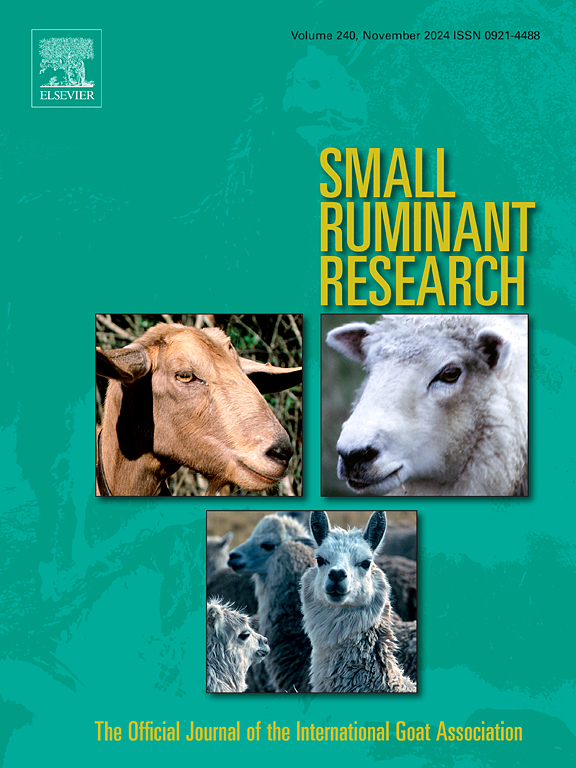农场分离噬菌体对大肠杆菌致羔羊腹泻的防治作用
IF 1.6
3区 农林科学
Q2 AGRICULTURE, DAIRY & ANIMAL SCIENCE
引用次数: 0
摘要
如果对多重耐药细菌感染的抗菌治疗失败,噬菌体的使用就成为焦点。这项研究是一项概念验证(POC),并调查了精心挑选的大肠杆菌噬菌体(Φ IA-38)是否优于常规抗生素感染后治疗新生儿羔羊大肠杆菌诱导的分泌性腹泻。此外,还对Φ IA-38的预防应用进行了研究。为此目的,从一个小型绵羊农场的污水样本中分离出Φ IA-38。该分离物对多种大肠杆菌菌株具有广泛的裂解活性,其基因组不含抗生素抗性基因和毒力基因。试验选用1 ~ 7日龄、体重3.2 ~ 5.7 kg的阿瓦西羔羊36只(公20只,母16只),随机分为4个试验组,分别为3个处理组和1个对照组。简而言之,1组为对照组,未被感染,也未接受噬菌体;2组感染24 h后给予普鲁卡因青霉素联合双氢链霉素治疗;第3组在感染前12 h进行预防治疗,第4组在感染后1 d进行预防治疗。单剂量大肠杆菌K99(0.1 mL;10⁷CFU/mL)口服治疗感染。羔羊肌内注射0.1 mL噬菌体Φ IA-38(10⁷PFU/mL;MOI:1)噬菌体治疗3天。除常规血液学和临床生化外,测定血清淀粉样蛋白A (SAA)、粘接珠蛋白(Hpt)、免疫球蛋白M (IgM)和免疫球蛋白G (IgG)的血药浓度,以估计炎症和一般免疫反应的程度。没有一只羊羔死亡。除对照组外,其余羔羊均有轻度至重度腹泻。第1天以后,第2组动物SAA浓度在各时间点均升高,第4组动物Hpt浓度在第10天下降(P <; 0.05)。第7天,噬菌体处理3组和4组IgM水平高于阴性对照组和笔链处理其他组(P <; 0.05)。IgG水平仅在第7天和第10天显著升高(P <0.05)。在第1天之后的所有时间点,抗生素治疗动物(第2组)的SAA浓度均升高。在Φ ia治疗的动物(第4组)中,Hpt水平已经最低,并且在第10天显著(p <; 0.05)下降。第7天,预防组(3组)和治疗组Φ IA-38治疗组(4组)IgM水平高于阴性对照组和penp -strep治疗组(P <; 0.05)。IgG水平仅在感染前预防性注射噬菌体的第7天和第10天显著升高(P <; 0.05)。预防性和治疗性IA-38治疗显著降低了感染羔羊粪便中的大肠杆菌K99计数(p <; 0.05),与抗生素治疗相似。然而,在第10天没有完全消除大肠杆菌k99。总之,我们显示了Φ IA-38治疗的POC,但剂量和治疗时间不足以消除所有大肠杆菌K99。需要进一步的研究来优化消除新生儿羔羊肠道多重耐药产肠毒素大肠杆菌(ETEC)感染。本文章由计算机程序翻译,如有差异,请以英文原文为准。
Prophylactic and therapeutic effects of isolated farm bacteriophages in lamb diarrhea induced by Escherichia coli
If antimicrobial treatment of infections by multidrug-resistant bacteria fails, the use of bacteriophages comes into focus. This study was a proof of concept (POC) and investigated if carefully selected E.coli bacteriophages (Φ IA-38) are superior to routine antibiotic post-infection treatment of E. coli-induced secretory diarrhea in neonatal lambs. Furthermore, the prophylactic application of Φ IA-38 was also investigated in the same trial. For this aim, a Φ IA-38 was isolated from sewage samples from a small sheep farm. The isolate had broad lytic activity against various E. coli strains, and its genome contains no antibiotic resistance or virulent genes. For the clinical part, 36 Awassi lambs (20 males, 16 females), aged 1–7 days and weighing 3.2–5.7 kg, were randomly allocated to four experimental groups comprising three treatment groups and one control group. Briefly, group 1 was the control group that was not infected nor received bacteriophages; group 2 was infected and treated 24 h later with a combination of procaine penicillin and dihydrostreptomycin; group 3 was treated prophylactically 12 h before infection, and group 4 was infected and treated 1 day after infection. A single dose of E. coli K99 (0.1 mL; 10⁷ CFU/mL) was given orally for infection. Lambs intramuscularly received 0.1 mL of phage Φ IA-38 (10⁷ PFU/mL; MOI:1) for 3 days for phage therapy. Next to routine hematology and clinical biochemistry, blood concentrations of Serum amyloid A (SAA), Haptoglobin (Hpt), immunoglobulin M (IgM), and immunoglobulin G (IgG) were determined to estimate the magnitude of inflammatory and general immune responses. None of the lambs died. All other lambs had mild to severe diarrhea except for the control group. SAA concentrations in the animals of Group 2 were increased at all time points after day 1, whereas the Hpt levels had decreased on day 10 in Group 4 (P < 0.05). IgM levels on day 7 were higher in phage-treated Groups 3 and 4, compared to the negative control and the pen-strep-treated other groups (P < 0.05). The IgG levels were significantly increased only in the animals of Group 3 on the 7th and 10th days (P <0.05). SAA concentrations in the animals treated with antibiotics (Group 2) were increased at all time points after day 1. In the Φ IA-therapeutically treated animals (Group 4), Hpt levels were already lowest and had significantly (p < 0.05) decreased by day 10. IgM levels on day 7 were higher in the prophylactic (Group 3) and therapeutic Φ IA-38- treated groups (Group 4) compared to the negative control and the pen-strep-treated groups (P < 0.05). The IgG levels were significantly increased only in the animals that had received the bacteriophages prophylactically before infection on the 7th and 10th days (P < 0.05). Prophylactic and therapeutic IA-38 treatment reduced significantly (p < 0.05) E. coli K99 counts in the feces of infected lambs, similar to the antibiotic treatment. However, complete E. coli K 99 elimination was not reached by day 10. In conclusion, we showed the POC for Φ IA-38 therapy, but dosing and treatment duration were insufficient to eliminate all E. coli K99. Further studies are warranted to optimize the elimination of multi-resistant Enterotoxigenic E. coli (ETEC) infection of the intestinal tract of neonatal lambs.
求助全文
通过发布文献求助,成功后即可免费获取论文全文。
去求助
来源期刊

Small Ruminant Research
农林科学-奶制品与动物科学
CiteScore
3.10
自引率
11.10%
发文量
210
审稿时长
12.5 weeks
期刊介绍:
Small Ruminant Research publishes original, basic and applied research articles, technical notes, and review articles on research relating to goats, sheep, deer, the New World camelids llama, alpaca, vicuna and guanaco, and the Old World camels.
Topics covered include nutrition, physiology, anatomy, genetics, microbiology, ethology, product technology, socio-economics, management, sustainability and environment, veterinary medicine and husbandry engineering.
 求助内容:
求助内容: 应助结果提醒方式:
应助结果提醒方式:


